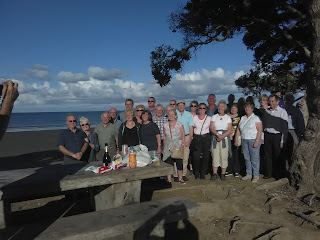Best of New Zealand - 26th February - Taupo
Saturday 26th February – Wairakei
Levin is a town in the Manawatu-Wanganui region of New Zealand, and is the largest town in the Horowhenua district. It is on State Highway 1 and the North Island Main Trunk railway.
The town was named after William Hort Levin, a director of the Wellington and Manawatu Railway Company. The name is a variation of the Jewish clan Levi. It is a shibboleth – unlike the usual pronunciation of the surname, stress is placed on the second syllable of the word. The name thus rhymes with the word 'begin'. The town's Maori name is Taitoko.
Levin is a service centre for the surrounding rural area, and a centre of light manufacturing. According to the June 2010 estimate, the estimated resident population was 19,550. Over 20% of inhabitants were listed as over the age of 65, a considerably higher percentage than the national average.
Taihape is a rural supply town and was at its peak during the 1960s when it was a railway and transport hub for the surrounding farming community. Much of its economic activity revolved around the railway and rural communities. A major decline occurred in the 1980s due to a restructure and electrification of the railway system and a general downturn in the farming sector. In recent years with the advent of major tourist attractions Taihape is now experiencing an upturn in local commerce. Its location on the North Island Main Trunk Railway and on State Highway 1 has ensured its economic survival. Taihape's main claim to fame is as the "Gumboot Capital of the World", and it attracts large numbers of people to the annual gumboot-throwing contest.
The Taihape region was originally inhabited by local Maori tribes who settled the area well before the arrival of Europeans; descendants of these tribes still live in the area. The first record of a European to the region is William Colenso's visit in 1845. In 1884, the surveyor's party for the Main Trunk railway line cut a rough track through the district.
The town was founded in 1894, when European settlers arrived from Canterbury in the South Island. The site of the town was a small natural clearing in dense native bush, which the first settlers set about clearing. Many of the original families have descendants still living in the area. The settlement was first called Hautapu after the local river, then Otaihape ("the place of Tai the Hunchback"), and finally Taihape.
Before the establishment of the railway, the bulk of farming produce (wool) had to be transported east by horse and bullock cart to Napier, from where it was exported. Until the establishment of roads and railways in the early 1900s, Taihape, like other rural towns, remained largely an isolated pioneer settlement.
Taupo is a town on the shore of Lake Taupo in the centre of the North Island of New Zealand. It is the seat of the Taupo District Council and lies in the southern Waikato Region.
Taupo has a population of 22,300. In 1953, Taupo was officially constituted as a borough, but from 1989 it has been administered by the Taupo District Council.
The name Taupo comes from Māori Taupō-nui-a-Tia. Literally translated, it means "The great cloak of Tia" where Tia is the name of the discoverer of the lake.
Taupo is located at the outlet of Lake Taupo, New Zealand's largest lake, in the north east part of the lake where it discharges to the Waikato River. The river flows over one of New Zealand's most spectacular waterfalls, Huka Falls, a short distance north of the town. Taupo is a centre of volcanic and geothermal activity and hot springs suitable for bathing are located at several places in the vicinity. The volcanic mountain of Mount Tauhara lies six kilometres to the east.
Craters of the Moon Thermal Area (or Karapiti in Māori language) is a region with geothermal activity north of Taupo. It is a part of Wairakei, the largest geothermal field in New Zealand, with a surface area of about 25 sq KM, which lies in the Taupo Volcanic Zone. The name springs from the many hydrothermal eruption craters, which are in part barren and which have bright colours. Combined with the numerous steam vents, constantly shifting, collapsing and reforming giving the whole area desolate appearance, and the sulphur smell, the whole area has an “unearthly” atmosphere. The craters are a relatively recent feature of the area and appeared as a result of human activity in the region.
The Huka Falls are a set of waterfalls on the Waikato River that drains Lake Taupo inNew Zealand. A few hundred metres upstream from the Huka Falls, the Waikato River narrows from roughly 100 metres across into a narrow canyon only 15 metres across. The canyon is carved into lake floor sediments laid down before Taupo's Oruanui eruption 26,500 years ago.
The volume of water flowing through often approaches 220,000 litres per second.
At the top of the falls is a set of small waterfalls dropping over about 8 metres. The most impressive, final stage of the falls is an 11 metre drop.
The Journey
Leaving Wellington we travel to Levin for our morning stop. The in is on to Taihape for lunch, a short stop in Taupo, before we visit the geo thermal area of Craters of the Moon, a photo stop at the Huka falls before arriving at our Hotel, the Wairakei Resort, choice of two restaurants, one serving A la Carte and the other offer a buffet ($29.50).


Comments
Post a Comment